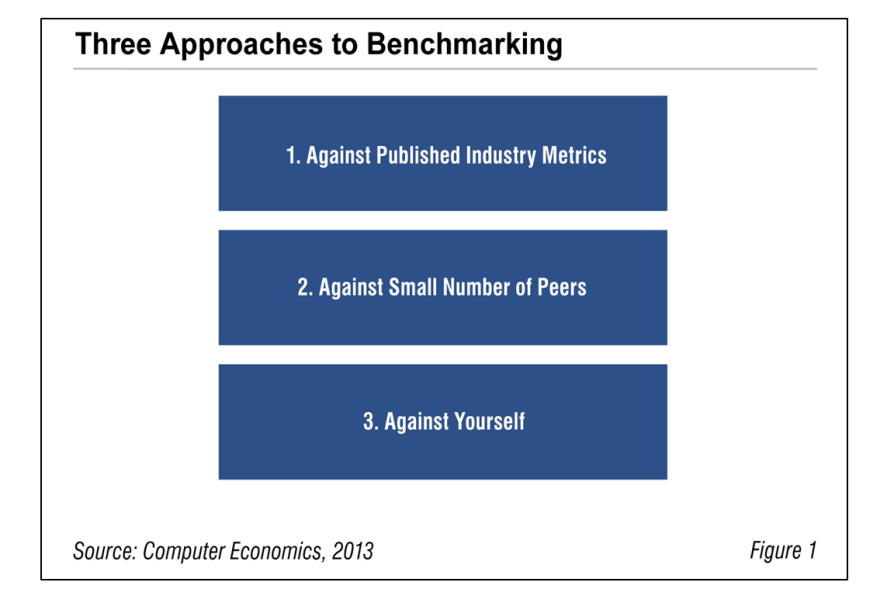Benchmarking is a time-tested way for IT executives to justify their IT budgets and focus on continuous improvement. Whether it is to compare their IT spending levels with industry peers, defend current spending levels, justify new spending requests, or identify opportunities for cost improvement, benchmarking is the only way to objectively measure an organization’s IT budget against industry standards.
Before embarking on a benchmarking project, an organization first needs to decide on the overall approach it wants to take in benchmarking. Will it benchmark against published industry metrics or against a small group of hand-picked peer organizations?
There are three basic ways to benchmark an organization’s IT budget ratios, as shown in Figure 1 from our report, Best Practices in Benchmarking IT Budget Ratios. The most common way is to measure the organization’s IT spending levels against published industry metrics, such as those offered by Computer Economics and other research organizations. Alternatively, an organization may solicit a small number of industry peers to take part in a special benchmarking study. Finally, an organization may benchmark itself against itself, either measuring one of its business units against others, or comparing budgetary ratios over time.

Each of these approaches has its advantages and disadvantages.
-
- Benchmarking against published industry metrics is the easiest and quickest approach. Industry metrics are relatively easy to obtain from sources such as Computer Economics and other research firms. The organization can then conduct its own benchmark or hire a consulting firm to perform the analysis. The disadvantage, however, is that the organization will be limited to metrics contained within the published benchmarks. Generally, however, these metrics will be sufficient for most purposes.
- Benchmarking against a small number of industry peers provides the most flexibility but is difficult to carry out. Since an organization selects its own peer group, it can select the exact type of organization that it feels should participate. In addition, an organization can design its own special metrics that would otherwise not be covered in published industry metrics. On the other hand, it may be difficult to get organizations to participate, especially if they compete against one another. Organizations that adopt this approach often find the effort required is far greater than anticipated.
- Benchmarking an organization against itself can provide deeper insights. Large organizations where each business unit largely maintains its own IT organization can benchmark business units against each other. In addition, a business can establish a baseline benchmark and then repeat the exercise annually or bi-annually and track changes over time. The drawback to this approach is that the organization is only measuring itself against itself and does not gain industry perspective.
These three approaches are not mutually exclusive. In fact, the best approach may be to first benchmark against published industry metrics, and then see whether the results are adequate or whether a “consortium approach” with a hand-selected group of peer companies is really needed. Finally, benchmarking business units against one another repeatedly over time is always a useful aspect of an ongoing program.
The full report, based on many years of Computer Economics’ experience, provides best practices for benchmarking an organization’s IT budget ratios against industry and peer-group metrics. It reflects the principles that we have found most important in making benchmarking a meaningful exercise. These best practices also reflect lessons learned from the mistakes we see IT organizations have made in their prior benchmarking efforts. It identifies five best practices for defining peer groups, selecting key metrics, understanding variations by industry and organization size, analyzing gaps, and translating findings into actions.
This Research Byte is a brief overview of our report on this subject, Best Practices for Benchmarking IT Budget Ratios. The full report is available at no charge for Avasant Research subscribers, or it may be purchased by non-subscribers directly from our website (click for pricing).

